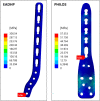Biomechanical performance evaluation of a modified proximal humerus locking plate for distal humerus shaft fracture using finite element analysis
- PMID: 37758839
- PMCID: PMC10533898
- DOI: 10.1038/s41598-023-43183-x
Biomechanical performance evaluation of a modified proximal humerus locking plate for distal humerus shaft fracture using finite element analysis
Abstract
The extra-articular distal humerus plate (EADHP) has been widely used for surgical treatment of distal humerus shaft fracture (DHSF). However, the surgical approach, fixation methods, and implant positions of the EADHP remain controversial owing to iatrogenic radial nerve injury and complaints such as skin irritation related to the plate. Anterior plating with a modified (upside-down application) proximal humerus locking plate (PHILOS) has been proposed as an alternative, However, research on its biomechanical performance remain insufficient and were mostly based on retrospective studies. This study quantitatively compared and evaluated the biomechanical performance between posterior plating with the EADHP and anterior plating with a modified PHILOS using finite element analysis (FEA). The FEA simulation results that both the EADHP and PHILOS had adequate biomechanical performance and stability under axial, bending, and varus force load conditions. The PHILOS has a fixed stability comparable to that of the EADHP, and fixation was achieved using only four locking screws within a fixed range of 30 mm just above the olecranon fossa. The results show that the PHILOS could be an option for the fixation of a DHSF when considering the dissection range and complaints (e.g. skin irritation) associated with the EADHP.
© 2023. Springer Nature Limited.
Conflict of interest statement
The authors declare no competing interests.
Figures




Similar articles
-
Biomechanical evaluation of a modified proximal humeral locking plate application for distal extra-articular diaphyseal humeral fractures.J Orthop Res. 2021 Sep;39(9):1877-1883. doi: 10.1002/jor.24925. Epub 2020 Dec 1. J Orthop Res. 2021. PMID: 33222233
-
Comparative study of mechanical performance of various fixation constructs in multifragmentary distal humeral shaft fracture: a finite element analysis.Eur J Orthop Surg Traumatol. 2024 Apr;34(3):1287-1296. doi: 10.1007/s00590-023-03790-w. Epub 2023 Dec 10. Eur J Orthop Surg Traumatol. 2024. PMID: 38071686
-
Management of extra-articular fracture of the distal humerus with the upside-down use of PHILOS plates in front of the humerus: a retrospective study of 20 patients after 28.3 months.BMC Musculoskelet Disord. 2024 Nov 25;25(1):952. doi: 10.1186/s12891-024-08098-2. BMC Musculoskelet Disord. 2024. PMID: 39587632 Free PMC article.
-
Biomechanical Design Optimization of Distal Humerus Fracture Plates: A Review.Biomed Res Int. 2024 Jun 27;2024:6015794. doi: 10.1155/2024/6015794. eCollection 2024. Biomed Res Int. 2024. PMID: 38966093 Free PMC article. Review.
-
Evolving fracture management: the role of helical plating in orthopaedic trauma surgery - a narrative review.Eur J Trauma Emerg Surg. 2025 May 12;51(1):203. doi: 10.1007/s00068-025-02871-1. Eur J Trauma Emerg Surg. 2025. PMID: 40353854 Free PMC article. Review.
Cited by
-
Comparative Analysis of Anterolateral and Posterior Approaches for Distal Humerus Shaft Fractures: A Multicenter Retrospective Study.J Clin Med. 2025 Apr 22;14(9):2890. doi: 10.3390/jcm14092890. J Clin Med. 2025. PMID: 40363922 Free PMC article.
-
Quantifying the Positional Deviation Between the True Flexion-Extension and Epicondylar Axes of the Elbow: A 3D Computational Study.Cureus. 2024 Oct 4;16(10):e70816. doi: 10.7759/cureus.70816. eCollection 2024 Oct. Cureus. 2024. PMID: 39493058 Free PMC article.
-
Effect of different constraining boundary conditions on simulated femoral stresses and strains during gait.Sci Rep. 2024 May 11;14(1):10808. doi: 10.1038/s41598-024-61305-x. Sci Rep. 2024. PMID: 38734763 Free PMC article.
References
Publication types
MeSH terms
LinkOut - more resources
Full Text Sources
Medical

